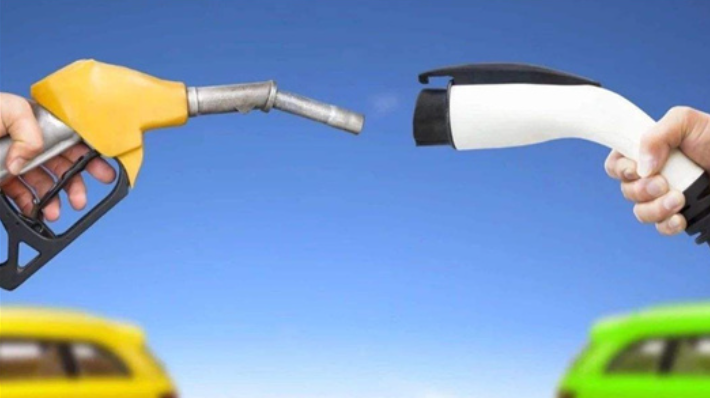The Decline of Gasoline Cars in China
In 2009, Nokia enjoyed the highest profits and premiums in the industry with a 39% market share, little did anyone know that it was already the peak of Nokia’s dominance. Just a year later, with the appearance of the iPhone 4, smartphones exploded onto the scene. By 2014, Nokia had fallen from the world’s top market share to “Others” on the statistics chart, and all of this happened in less than five years.
Now, the “Nokia moment” of gasoline cars has quietly arrived in the Chinese market.
The decline of traditional gasoline cars came unexpectedly. In the first half of this year, after experiencing a brief period of glory in 2021, they also began to decline.
The Waning of the Gasoline Car Market
The defeat of gasoline cars is sudden.
On July 15th, the sales data for the passenger car market in June was officially released. The new car insurance data showed that the number of new passenger car insurance policies for June was 1.93 million, an increase of 14.5% year-on-year. This is the first year-on-year positive growth in nearly a year since July of last year.
However, excluding new energy vehicles, which saw a year-on-year increase of 129.1%, the sales volume of traditional gasoline cars in June still fell by 2.6% year-on-year. This was achieved with the support of unprecedented purchase tax reductions (mainly aimed at gasoline cars and covering models up to 2.0T, which was previously unimaginable), and the additional “50% subsidy for purchase tax” offered by many car companies.

The insurance policy data showed that the number of new passenger car insurance policies between January and June was 9.16 million, which is a 12.1% year-on-year decrease. Among them, the number of new energy vehicle policies was 2.1 million, which is a 110.6% year-on-year increase. The penetration rate of new energy increased from 9.56% in the same period last year to 22.9% in the first half of this year, a year-on-year increase of 139.54%.
While the overall market saw a slight decline, new energy vehicles achieved a doubling of growth. This means that gasoline cars are experiencing a significant decline: the number of gasoline car insurance policies from January to June was 7.06 million, a year-on-year decrease of 25.06%.
These are the sales figures, but what about the production figures? According to data from the China Passenger Car Association, the production of gasoline cars was 7.695 million units between January and June, a year-on-year decrease of 9.14%. Meanwhile, the sales volume was 6.693 million units, a year-on-year decrease of 21.95%. At the same time, the net inventory increased by 702,000 units in the first half of the year.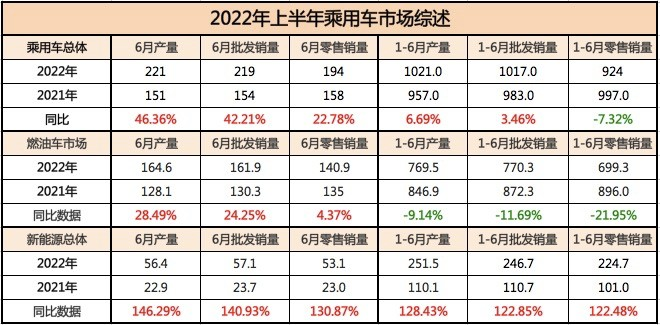
Now, both from the production and consumption perspectives, the sales and production of fuel vehicles have begun to decline by double digits year-on-year, a situation that last occurred in 2018-2019 when the entire passenger car market began to decline from its peak, of course, at that time, there was no story of new energy vehicles growing exponentially.
Myths about Resale Value of Used Fuel Vehicles Shattered
The myth of high resale value for fuel vehicles has also begun to be shattered.
In early July, 17 departments, including the Ministry of Commerce, issued a notice to support the scale development of the used car circulation, and strict implementation of the policy to fully lift the restrictions on the migration of used cars in all regions, including the nationwide cancellation of restrictions on the migration of small non-operational used cars that meet the national emissions standards for country five from August 1, 2022 (including areas defined as key areas for the prevention and control of air pollution by the state).
The introduction of this policy has brought about another dangerous signal to the already precarious used car market across the country – the price of used fuel vehicles may not hold up, and the “resale value myth” has begun to be shattered. According to the information from the investigation conducted by China Passenger Car Association (CPCA), the average inventory cycle of used cars increased by more than three days YoY, reaching 47 days in June, and the proportion of cars staying in stock for over 30 days has risen to 35.7%.
Longer inventory cycles of used cars naturally lead to a drop in prices. According to the “June China Automobile Resale Value Study Report” released by China Automobile Dealers Association (CADA), the resale value of vehicles of all levels in June fell by 1-2% compared to May. Even Japanese and German brands, which used to have the highest resale values, saw significant declines. Toyota fell by 1.8% MoM, Honda by 1.8 percentage points, Nissan by 2.1 percentage points, and Volkswagen by 1.2 percentage points.
This trend has affected even luxury brands. Mercedes-Benz fell by 1.7 percentage points in June, BMW by 0.3 percentage points, and Audi by 1.3 percentage points. In a typical year, the month-on-month decline in resale value is generally between 0.1-0.5 percentage points in June-July.
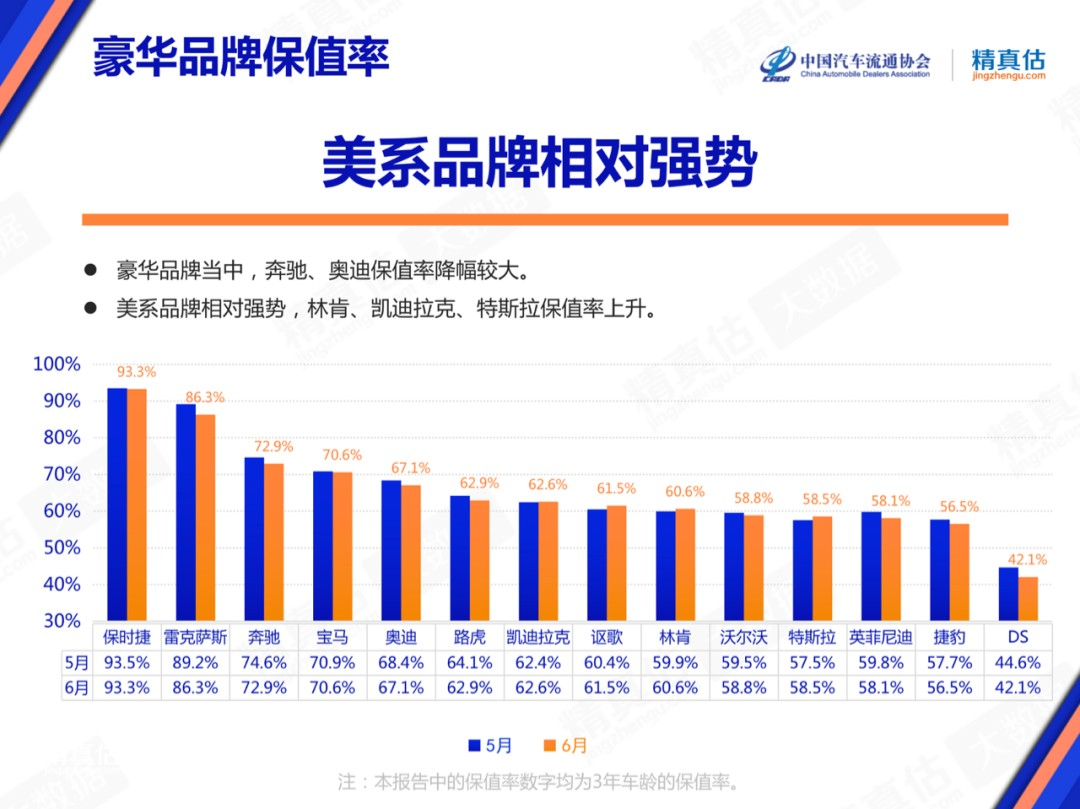 Meanwhile, the resale value of new energy passenger cars, which was once criticized by many, has begun to rise against the trend. For example, Tesla’s resale value increased from 57.8% in May to 58.5% in June, and the 3-year resale value of NIO ES6 reached 63.3%, second only to Audi’s 67.1% among luxury brands and ranking fifth overall.
Meanwhile, the resale value of new energy passenger cars, which was once criticized by many, has begun to rise against the trend. For example, Tesla’s resale value increased from 57.8% in May to 58.5% in June, and the 3-year resale value of NIO ES6 reached 63.3%, second only to Audi’s 67.1% among luxury brands and ranking fifth overall.
The change in the second-hand car market is essentially the transmission of the changes in the new car market. When the sales of new fuel vehicles perform poorly and begin to guarantee sales through promotions and discounts, the price of used fuel vehicles naturally falls.
On the other hand, the overall supply and demand of new energy vehicles is relatively balanced (with the exception of a few vehicles with long production cycles such as Tesla and BYD), and the many price increases due to subsidy cuts and upstream battery price increases in the first half of the year have also been transmitted to the new energy second-hand car market, driving a comprehensive firmness in the prices of new energy second-hand cars.
If fuel vehicles’ biggest advantage, “resale value,” cannot be upheld, can BBA, as a luxury brand, withstand the impact?
Can BBA be spared?
In the first half of the year, joint venture brands lowered their overall terminal prices, and the policy stimulus of halving the purchase tax slowed down the decline in fuel vehicle sales in June. Among luxury brands, except Tesla, which serves as a new energy vehicle company, concentrated its deliveries at the end of the quarter to some extent to regain its face, the market performance of other luxury cars was weak overall.
In the first half of 2022, the market share of luxury brands was 19.5% (an increase of 0.5% compared to the previous month, mainly due to Tesla’s concentrated deliveries), a decrease of 0.59% compared to the same period in 2021; joint venture brands’ share was 40.1%, a decrease of 5.32% compared to the same period in 2021; and independent brands’ share was 40.5%, an increase of 5.91% compared to the same period in 2021.
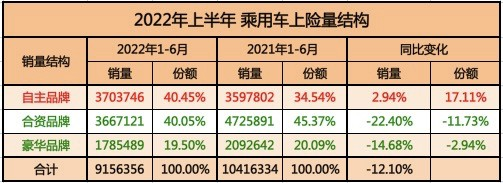
Looking at absolute sales, the performance of the overall luxury brand market in the first half of the year was poor. Even the mighty BBA did not perform well.
From January to June, Mercedes-Benz’s insurance coverage volume was 367,056 vehicles, a year-on-year decrease of 16.93%; BMW’s insurance coverage volume was 363,515 vehicles, a year-on-year decrease of 19.09%; and Audi’s insurance coverage volume was 301,582 vehicles, down 25.12% year-on-year.
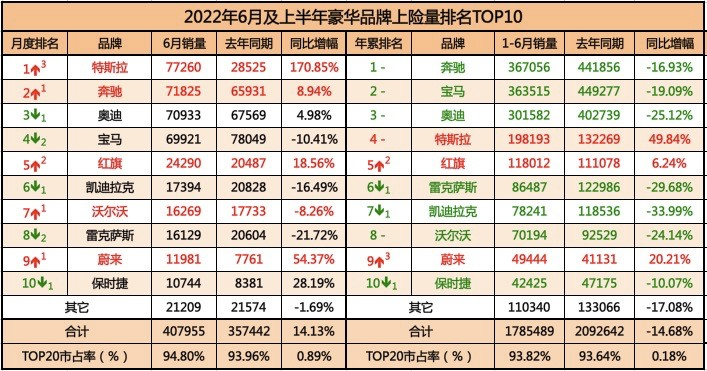
In the first half of the year, the combined sales of BBA, the three major luxury car brands, amounted to 1,032,153 units, down more than 20% YoY. BBA’s market share in the luxury car market also dropped below 60% for the first time, standing at only 57.81%, representing a decrease of 4.02 percentage points compared to the same period last year.
It can be said that in this wave of “fuel car collapse,” the hardest-hit are joint-venture brands, followed by luxury brands, while independent brands (especially those with high proportions of new energy vehicles) benefit the most.
If the fuel cars of luxury brands are not performing well, can new energy vehicles take their place?
Let’s take a look at some data: from January to June, BMW’s new energy passenger cars (including imported models) amounted to 22,908 units, accounting for 6.30% of the brand’s total sales; Mercedes-Benz’s new energy vehicle sales amounted to 19,654 units, accounting for 5.35% of its total sales; and Audi’s new energy vehicle sales amounted to 3,119 units, accounting for 1.03% of its total sales.
From this data, it is clear that BBA is still heavily reliant on fuel cars as its absolute sales force, and thus its sales decline is equally evident in this “internal and external trouble” wave.
Do you remember the argument put forward in 2018 or 2019 that “All new forces cannot survive once BBA promotes new energy products”? Now in 2022, new forces are still creating their own sales highs, while BBA has been trapped in the “dilemma of new energy.”
On the one hand, BBA’s fuel cars are still very powerful on the market with high brand awareness and profit margins.
Although everyone knows that transition was inevitable, it is difficult for anyone to give up their “cash cow” immediately – even the founders themselves may not be able to do it, let alone the team of professional managers.
On the other hand, BBA’s new energy products are too “traditional” (conservative). Their target customers are mostly highly aware of the brand but unfamiliar with independent brands – essentially they are diverting their own fuel car customers.
However, the first half of 2022 has been difficult for BBA, and their fuel cars are not doing so well, let alone their “convert-to-electricity” versions of new energy cars. For those who have truly reached the budgeted target customers, how many of them, after knowing more about new forces and independent brands, will still choose BBA’s new energy products?
This is the case for Audi’s e-tron, Mercedes-Benz’s EQC, and BMW’s iX 3 – even the most aggressive new energy models in BBA, the BMW iX and Mercedes-Benz EQS, have already lost their competitiveness based on pricing.
In fact, EQS has begun to frequently offer discounts – if the original discount of 200,000 yuan is not enough, then let’s offer a 250,000 yuan discount. Although this discount is not much in comparison to the total price, it is still an important signal.You should know that the S-Class has always been Mercedes-Benz’s flagship product. But a discounted flagship product means that, as we enter the new era of new energy, the “brand power” that BBA was once proud of is gradually losing its “magic”.
Just as smartphones replaced feature phones in terms of products and intelligent experience when more and more new energy passenger cars comprehensively surpassed fuel vehicles.
When more and more consumers in non-restricted, non-restricted purchase areas vote with their feet and choose BYD, Tesla, and new forces.
When the replacement of new energy for fuel vehicles occurs in more and more cities, in more and more households, and among more and more people around us.
The Nokia moment for fuel vehicles has arrived.
This article is a translation by ChatGPT of a Chinese report from 42HOW. If you have any questions about it, please email bd@42how.com.
